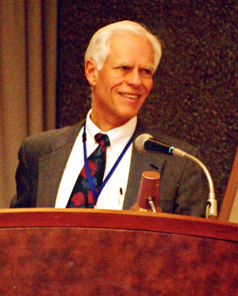|
 |
The study of pitch is an important part of communication acoustics. But how could human beings get the perception of pitch? This is still a mysterious question to many of us. So on Jun. 15, our institute invited the famous professor William Morris Hartmann to give us a lecture on this subject.
William Morris Hartmann is a distinguished professor of Michigan State University. His study mainly focused on psychoacoustics dealing with pitch perception, signal detection, modulation detection, and localization of sound. He is a member of the American Physical Society, the Association for Research in Otolaryngology, the American Association for the Advancement of Science and the Society for Music Perception and Cognition. In 2001 he received the Distinguished Faculty Award from Michigan State University and the Helmholtz-Rayleigh Silver Medal from the Acoustical Society of America. |
The report Prof. W. M. Hartmann gave us titled: Human Auditory Organization and the Perception of Pitch. At first, he gave us a general idea on neural encoding of frequency information. Our human beings' encoding consisted of pitch perception and timbre (tone color) perception. Then he used many vivid pictures to illustrate the two parts of auditory organization: sequential organization and concurrent organization. As for the role of pitch perception, he mentioned two points: integrating the harmonics of each voice to form a single perceptual entity and segregating the different voices to form different perceptual entities. But how to accomplish this feat? He thought it could be achieved through diverse principles and processes. After his analysis on mistuned harmonic paradigm and unmasking, he got his conclusion that pitch was a rather complex topic: Complex periodic tones lead to fused perceptual entities because of commensurate neural synchrony in different tonotopic channels. Multiple voices are heard when there is asynchrony within individual channels (tonotopically local). Abrupt change in synchrony in a small tonotopic region can pop out a tone. After the report, Prof. Hartmann had a warm discussion with the audience.
After the seminar, companied by Li Xiaodong, Director of Communication Acoustics Lab, Prof. Hartmann looked around the whole institute and highly praised the acoustic equipment devices and research condition in our institute.
|